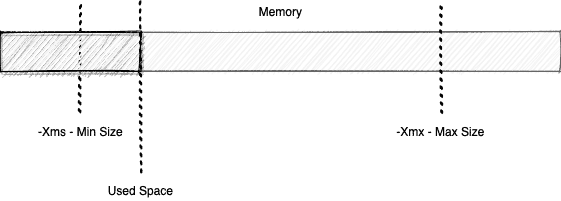1. 概述
本文将深入解析 JVM 堆内存中的三个关键指标:最大内存(Max)、已用内存(Used) 和 已提交内存(Committed) 的区别。
✅ 理解这些概念对排查内存问题、调优 GC 行为和合理设置 -Xmx/-Xms 参数至关重要。
❌ 很多开发者误以为“已用 = 实际占用”,其实背后还有操作系统和 JVM 内存管理的复杂机制。
我们将先了解 JVM 堆的自适应扩容机制,再逐一拆解这三个指标的含义。
2. 最大内存与自适应扩容机制
JVM 堆的大小由两个关键参数控制:
-Xms:JVM 启动时的初始堆大小-Xmx:堆内存的最大限制
# 示例:设置初始 512MB,最大 4GB
java -Xms512m -Xmx4g MyApp
⚠️ 如果你不显式设置这两个参数,JVM 会根据以下因素自动选择默认值:
- 操作系统类型(Windows/Linux/macOS)
- 物理内存总量
- JVM 实现版本(HotSpot、OpenJ9 等)
例如,在 64 位服务器版 JVM 上,若物理内存充足,-Xmx 的默认值可能是物理内存的 1/4。

堆内存从 -Xms 指定的初始值开始,随着对象不断分配,JVM 会逐步向操作系统申请更多内存,直到达到 -Xmx 设定的上限。
✅ 简单粗暴地说:
最大堆内存 =
-Xmx设置的值(未设置则用默认值)
这是硬性上限,JVM 堆绝不会超过这个值,否则会抛出 OutOfMemoryError。
3. 已用内存(Used)
已用内存指的是当前已被 Java 对象实际占用的堆空间大小。
比如你的应用创建了若干个 User、Order 等对象,这些对象实例所占的内存总和就是“已用内存”。

关键点:
- ✅
Used ≤ Max:已用内存不可能超过最大堆内存 - ✅ GC 会直接影响该值:一次 Full GC 后,已用内存通常会显著下降
- ⚠️ 即使对象被回收,
Used也不会立刻归零——因为堆可能不会立即收缩(取决于 GC 策略)
示例代码查看当前已用内存:
import java.lang.management.ManagementFactory;
import java.lang.management.MemoryMXBean;
import java.lang.management.MemoryUsage;
public class MemoryInfo {
public static void main(String[] args) {
MemoryMXBean memoryBean = ManagementFactory.getMemoryMXBean();
MemoryUsage heapUsage = memoryBean.getHeapMemoryUsage();
long used = heapUsage.getUsed(); // 已用内存(字节)
long max = heapUsage.getMax(); // 最大内存(字节)
System.out.println("Used: " + used / 1024 / 1024 + " MB");
System.out.println("Max: " + max / 1024 / 1024 + " MB");
}
}
输出示例:
Used: 128 MB
Max: 4096 MB
4. 已提交内存(Committed)
这是最容易被误解的一个概念。
已提交内存是 JVM 向操作系统申请并保证可用的物理内存大小。它代表 JVM 当前“手上有多少内存可用”,哪怕还没完全用上。
关键特性:
- ✅
Committed ≥ Used:已提交内存必须大于等于已用内存(否则放不下) - ✅ JVM 可以动态向 OS 申请或释放内存(通过
mmap/munmap等系统调用) - ✅ 提交内存可以小于最大内存:JVM 不会一次性把
-Xmx全部申请下来,而是按需提交
举个例子:
java -Xms128m -Xmx4g MyApp
- 启动时:
Committed = 128MB,Used可能只有几 MB - 随着对象增多:
Committed逐步增长到 512MB、1GB……直到接近 4GB - GC 回收后:
Used下降,但Committed可能不变(避免频繁系统调用)
用代码查看提交内存:
MemoryUsage heapUsage = ManagementFactory.getMemoryMXBean().getHeapMemoryUsage();
long committed = heapUsage.getCommitted(); // 已提交内存(字节)
System.out.println("Committed: " + committed / 1024 / 1024 + " MB");
输出示例:
Used: 128 MB
Committed: 512 MB
Max: 4096 MB
📌 一句话总结三者关系:
Used ≤ Committed ≤ Max
5. 总结
| 指标 | 含义 | 是否可变 | 决定因素 |
|---|---|---|---|
| Used | Java 对象实际占用内存 | ✅ 动态变化 | 对象分配与 GC |
| Committed | JVM 向 OS 申请的可用内存 | ✅ 动态申请/释放 | JVM 内存管理策略 |
| Max | 堆内存上限 | ❌ 固定(启动时确定) | -Xmx 或默认策略 |
✅ 实际开发中的建议:
- 监控
Used / Committed比例,过高可能预示 GC 压力大 - 生产环境建议设置
-Xms = -Xmx,避免运行时扩容带来的性能波动 - 使用
jstat -gc <pid>或 APM 工具(如 SkyWalking、Prometheus + JVM Exporter)持续观察这三个指标
理解这三个内存指标,能帮你更精准地定位内存泄漏、GC 频繁等问题,而不是一味地“加内存了事”。